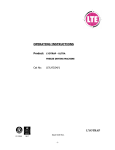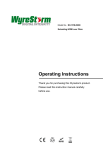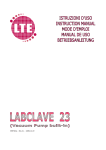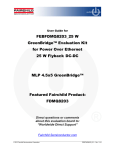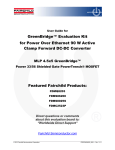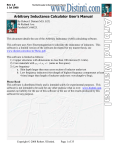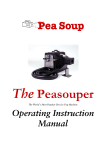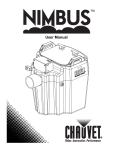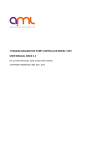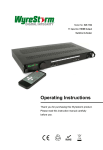Download OPERATING INSTRUCTIONS LYOTRAP
Transcript
OPERATING INSTRUCTIONS Product: LYOTRAP – PLUS FREEZE DRYING MACHINE Car No: FM 23948 0617 LF/LYO/03/1 Issue level No.1 LYOTRAP User Manual For Lyotrap Plus Freeze-Drying Machine Machine Serial No: …................ Software Ref: Pressure Vessel Ref: …................ …................ Description Of Any Options Fitted: ….................................................................................................................. ..................................................................................................................... ..................................................................................................................... ..................................................................................................................... ................................................................................................ Voltage: Power: Phase: It would be most helpful if you could have the above information available when requesting technical advice or after sales service. C H Perry Chairman, LTE Scientific Ltd Confidentiality All rights reserved. No part of this publication may be reproduced, stored in a retrieval system, or transmitted in any form or by any means, mechanical, photocopying, recording, or otherwise, without the prior written permission of LTE Scientific Limited. No patent liability is assumed with respect to the use of the information contained herein. While every precaution has been taken in the preparation of this manual, LTE Scientific Limited assumes no responsibility for errors or omissions. Neither is any liability assumed for damages resulting from the use of the information contained herein. CONTENTS 1. Page The Process and setting up…………………………………………………………..6 2. Controls.…………………………………………………………………………………..7 3. Machine Operation……………………………………………………………………..9 4. Heater…………………………………………………………………………………….10 5. General Maintenance………………………………………………………………….10 6. Troubleshooting…………………………………………………………………………11 1. The Process The products to be freeze-dried are placed in the specimen chamber (the larger of the two chambers) on the LYOTRAP-PLUS. To freeze the products, press the condenser chamber button on the control panel to start refrigeration and then the specimen chamber button. When the products are frozen to the desired temperature, the specimen chamber refrigeration can be switched off, leaving only the condenser chamber refrigeration running. When the condenser chamber (the smaller chamber) temperature is below -30°C the vacuum pump can be switched on. As vapour comes away from the products, it will be seen forming as frost on the sides of the condenser chamber. Heat going into the products causes the ice to sublimate, or vaporise. All the ice in the products will eventually boil off, without actually melting. As the cell walls should not have collapsed during the process, the dried product should have retained its fresh appearance and chemical or nutritional composition. Setting Up To operate correctly, the machine needs to be level. The environment needs to be dustfree to avoid the refrigeration heat exchanger fins at the left-hand side of the machine from becoming clogged. The LYOTRAP-PLUS freeze-dryer needs about half a metre of clear space at each end and to be in a well ventilated area to allow adequate air circulation. 2. Controls LED’S Light up then the function is active Power The power LED will light up when the machine is connected to a power supply and switched on. The machine must be isolated from the power supply when not in use or when any maintenance work is undertaken. Heater The heater puts heat into main chamber to accelerate drying of the products and is regulated by the temperature control downward facing button on the control panel. One touch of this button displays the target temperature of the specimen chamber. To change this temperature, you can scroll up or down with the up or down pointing buttons. Vacuum Pump Switches on vacuum pump, but it will only operate when the condenser chamber temperature is below -30°C. Refrigeration When the condenser chamber button is pressed, the condenser refrigeration will start and the condenser chamber temperature will be displayed. .when the Specimen chamber button is pressed, the specimen chamber refrigeration will run and the specimen chamber temperature will be displayed. The condenser chamber refrigeration will always run at the same temperature as the specimen chamber. Pressing the downward pointing temperature control button sets the specimen chamber target temperature. One touch of this button displays the cut out temperature of the chamber. To change this temperature, you can scroll up or down with the up or down pointing buttons. The lowest temperature achievable in the specimen chamber will be approximately -35°C. Defrost This function will only work when the refrigeration system is switched off. Vacuum Display This display is in Millibars, or 1000ths of atmospheric pressure. It shows the level of vacuum in the system and this will vary throughout the drying cycle. This is because the products are giving off water vapour and gases that spoil the reading. Near the end of the cycle the pressure will be lower. The display will read OFF while the vacuum pump is switched off. When the vacuum pump is switched on, the display will read ON. When the pressure has dropped to about 500 Millibars, or half of atmospheric pressure, it will start to register the pressure. The display will be erratic initially but stabilise as operating pressure is reached. Temperature Display The temperature showing is the last temperature button selected as shown by the LED. Temperature probes 1 to 4 are the loose probes in the specimen chamber that can be inserted into samples chosen in different areas of the specimen chamber. 3. Machine Operation It is not advisable to have important product or samples in the machine when it is run for the first time. 1. Push the vacuum hose onto the stainless steel tube at the left side of the machine. Attach the vacuum pump isolation valve to the vacuum pump with the O ring and clamp provided. Push the other end of the vacuum hose to the tube on the vacuum pump isolation valve. 2. Connect the vacuum pump to the power outlet socket on the left side of the machine using the vacuum pump cable. Connect the machine to a suitable single-phase 220-240 volt power supply. Make sure the vacuum pump is switched on at the switch on the pump. 3. Insert the loose temperature probes in the specimen chamber into your samples to determine when they are frozen and then eventually dry. 4. Press the downward pointing temperature control button to select the temperature you wish to freeze the specimen chamber to. For the purposes of the practice run, set it to -30°C. Press the condenser chamber refrigeration button on the control panel and then the specimen chamber refrigeration button to freeze the chamber. 5. When the samples in the specimen chamber are adequately frozen, the specimen chamber can be switched off leaving only the condenser chamber refrigeration running. It will take about 30 minutes for the condenser chamber temperature to go down to -50°C or below. 6. Close the condenser chamber drain valve by turning the blue handle toward the front of the machine. Make sure the condenser chamber and specimen chamber lids are in place. When the condenser chamber temperature is below -30°C, press the vacuum pump button on the control panel to start the vacuum pump. The vacuum display will read ON for a few minutes but will eventually start to register the pressure from 500 millibar downwards. Press down on the chamber lids to ensure a good vacuum seal. 7. If the vacuum display reading stays ON, or if it does not drop below one millibar, then the system may be leaking. To find the leak you must switch off the vacuum pump, check all the seals and connections, the lids and the drain valve, then try again. 8. When the samples have reached a temperature at or approaching ambient then they are dry. 9. At the end of the process, the refrigeration and vacuum pump can be switched off. Slowly turn the handle on the drain valve to allow air back into the chambers. The defrost can be switched on to melt any ice in the condenser chamber if the machine is to be used immediately again. Otherwise it will just meld on its own. Place a container under the drain valve to collect the melting ice. The machine must be switched off when not in use. The drain valve must be closed before the machine can be used again. 4. Heater When used correctly the heater can shorten the drying cycle, however, it can lead to products being spoiled if overused. Heat is required to change the ice into vapour; too much heat however will cause the frozen products to melt. The specimen chamber heater is in the form of an element coiled around the outside of the chamber. Heat is radiated to the products and to a lesser degree, conducted through the very rarefied gases present in the chamber. Achieving an absolute vacuum is neither necessary nor possible. Heat will also enter the chamber as radiation through the clear acrylic lid. To operate the heating mechanism, it is necessary to observe the temperature of the specimen chamber. Press the downward pointing temperature control button on the control panel to display the target temperature for the specimen chamber. Using the up or down arrow pointing buttons, adjust this to temperature required. Switch on the heater and allow it to heat up to your required temperature. 5. Maintenance The vacuum pump oil must be changed whenever it becomes discoloured or cloudy. If the machine is used continuously then it must be changed monthly. The clear drain plug is removed to drain the old oil. Fresh oil is added by unscrewing the top of the mist filter and then removing the element. Oil mist and spillage around the vacuum pump can occur and should be wiped clean as it attracts dust and dirt. If the surfaces around the pump are kept clean, abnormalities such as oil leaks are immediately apparent. The rubber seals should be kept clean, any dirt being effectively removed with alcohol or white spirit on a cloth. Do not get solvents on the acrylic lids however. The refrigeration systems heat exchanger is at the left of the machine and is finned like a car radiator. This must be kept clean and away from anything that could restrict the airflow. The air must blow through to take the heat out of the refrigerant and cool the system. The fins should be kept clean by occasionally blowing out with compressed air or using a vacuum cleaner. 7. Troubleshooting If at anytime you do experience problems with your freeze-drying machine, the next section should help you determine the cause. Vacuum When starting the freeze drying process and switching on the vacuum pump, the vacuum display will read ON. As the pressure drops below approximately 500 x 1000ths of atmospheric pressure it will start to read the actual pressure in millibars or 1000ths of a bar. The reading will at first be (500) going down eventually to its operating pressure of (0.200) or below with some fluctuation at the first. If the pressure does not drop in this way would suggest a problem. 1. Make sure the switch on the vacuum pump itself, is on. 2. Check the condenser chamber and specimen chamber lids are both sealing correctly. 3. Check the hose connections and that the drain valve is not open. 4. Make sure that the temperature in the in the condenser chamber is below -30°C, otherwise the machine will not allow the vacuum pump to run. 5. Change the oil in the vacuum pump at regular intervals to maintain good vacuums. Refrigeration If after switching on the condenser chamber refrigeration, the temperature gauge fails to drop as low as expected it would suggest a refrigeration problem. If the specimen chamber refrigeration fails to reach the desired temperature, press the downward pointing temperature control button once, to display the target temperature. If this is set to a temperature above ambient the system will not run. Set it to -35°C or the temperature that you want to achieve and try again. Refrigeration problems require a trained refrigeration engineer. The system is charged with 1.2kg of R507 refrigerant. DECLARATION OF CONFORMITY PRODUCT LYOTRAP PLUS CATALOGUE NUMBER ……………………………………. SERIAL NUMBER ……………………………………. “We declare that the above CE marked product conforms with the following EU Directives.” EMC Directive - 89/336/EEC as amended by Directive 92/31/EEC. Low Voltage Directive - 73/23/EEC C H Perry, Chairman LTE Scientific Ltd, Greenbridge Lane, Greenfield, Oldham, OL3 7EN













